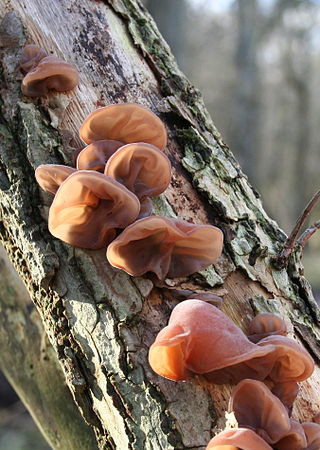
The Auriculariales are an order of fungi in the class Agaricomycetes. Species within the order were formerly referred to the "heterobasidiomycetes" or "jelly fungi", since many have gelatinous basidiocarps that produce spores on septate basidia. Around 200 species are known worldwide, placed in six or more families, though the status of these families is currently uncertain. All species in the Auriculariales are believed to be saprotrophic, most growing on dead wood. Fruit bodies of several Auricularia species are cultivated for food on a commercial scale, especially in China.

The Auriculariaceae are a family of fungi in the order Auriculariales. Species within the family were formerly referred to the "heterobasidiomycetes" or "jelly fungi", since many have gelatinous basidiocarps that produce spores on septate basidia. Around 100 species are known worldwide. All are believed to be saprotrophic, most growing on dead wood. Fruit bodies of several Auricularia species are cultivated for food on a commercial scale, especially in China.

Exidia is a genus of fungi in the family Auriculariaceae. The species are saprotrophic, occurring in attached or recently fallen dead wood, and produce gelatinous basidiocarps. The fruit bodies are diverse, pustular, lobed, button-shaped or cup-shaped. Several species, including the type species Exidia glandulosa, have sterile pegs or pimples on their spore-bearing surface. The genus has a cosmopolitan distribution and around 20 species are currently recognized worldwide. Initial molecular research indicates the genus is artificial.

Exidia glandulosa, commonly known as black witches' butter, black jelly roll, or warty jelly fungus, is a jelly fungus in the family Auriculariaceae. It is a common, wood-rotting species in Europe, typically growing on dead attached branches of oak. The fruit bodies are up to 3 cm (1.2 in) wide, shiny, black and blister-like, and grow singly or in clusters. Its occurrence elsewhere is uncertain because of confusion with the related species, Exidia nigricans.

Spongiforma thailandica is a species of fungus in the family Boletaceae, genus Spongiforma. The stemless sponge-like species, first described in 2009, was found in Khao Yai National Park in central Thailand, where it grows in soil in old-growth forests. The rubbery fruit body, which has a strong odor of coal-tar similar to Tricholoma sulphureum, consists of numerous internal cavities lined with spore-producing tissue. Phylogenetic analysis suggests the species is closely related to the Boletaceae genera Porphyrellus and Strobilomyces.

Exidia nigricans is a jelly fungus in the family Auriculariaceae. It is a common, wood-rotting species throughout the Northern Hemisphere, typically growing on dead attached branches of broadleaf trees. It has been much confused with Exidia glandulosa.

Sebacina is a genus of fungi in the family Sebacinaceae. Its species are mycorrhizal, forming a range of associations with trees and other plants. Basidiocarps are produced on soil and litter, sometimes partly encrusting stems of living plants. The fruit bodies are cartilaginous to rubbery-gelatinous and variously effused (corticioid) to coral-shaped (clavarioid). The genus has a cosmopolitan distribution.

Exidia recisa is a species of fungus in the family Auriculariaceae. In the UK, it has the recommended English name of amber jelly. Basidiocarps are gelatinous, orange-brown, and turbinate (top-shaped). It typically grows on dead attached twigs and branches of willow and is found in Europe and possibly elsewhere, though it has long been confused with the North American Exidia crenata.
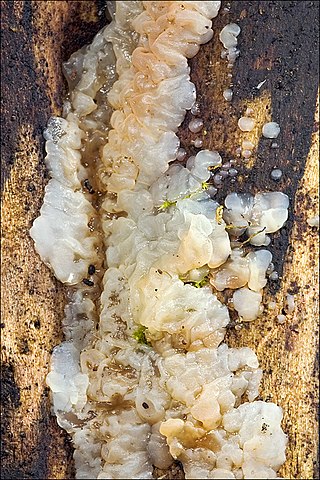
Exidia thuretiana is a jelly fungus in the family Auriculariaceae. The fruit bodies are white and gelatinous with brain-like folds. It is a common, wood-rotting species in Europe, typically growing on dead attached or fallen branches of broadleaf trees, especially beech.

Myxarium nucleatum is a species of fungus in the family Hyaloriaceae. In the UK, it has been given the recommended English name of crystal brain. The fruit bodies are watery white, pustular or lobed, and gelatinous with small, white, mineral inclusions visible to the naked eye. It is a common, wood-rotting species in Europe, typically growing on dead attached or fallen branches of broadleaf trees. It is currently not clear whether collections from North America and elsewhere represent the same species.

Auricularia nigricans is a species of fungus in the family Auriculariaceae. Basidiocarps (fruitbodies} are gelatinous, ear-like, and grow on dead wood of broadleaf trees. It is found in southern and eastern Asia, North America, South America and the Caribbean. Asian examples were formerly considered as a separate species described as Auricularia polytricha.
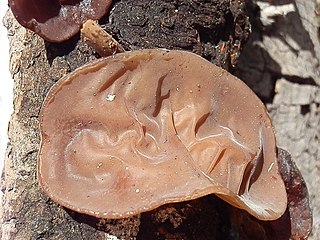
Auricularia americana is a species of fungus in the family Auriculariaceae found in North America and East Asia. Its basidiocarps (fruitbodies) are gelatinous, ear-like, and grow on dead conifer wood.

Auricularia angiospermarum is a species of fungus in the family Auriculariaceae. Basidiocarps (fruitbodies) are gelatinous, ear-like, and grow on dead wood of broadleaf trees. It is a North American species and was formerly confused with Auricularia auricula-judae which is confined to Europe.
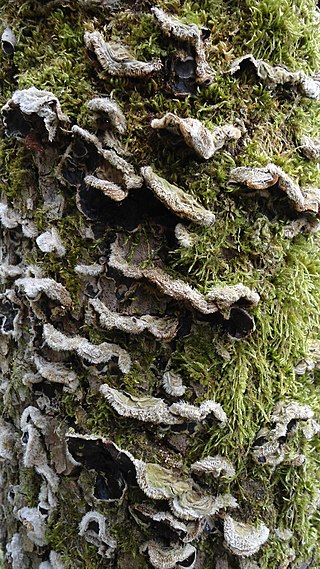
Auricularia mesenterica, commonly known as the tripe fungus, is a species of fungus in the family Auriculariaceae. Basidiocarps are gelatinous and typically formed in coalescing tiers on stumps and logs. They are partly pileate, with hirsute, zoned caps, and partly resupinate, with smooth to wrinkled undersurfaces that spread over the wood. Auricularia mesenterica is a saprotroph on dead deciduous trees and shrubs. The species is restricted to Europe and Central Asia.
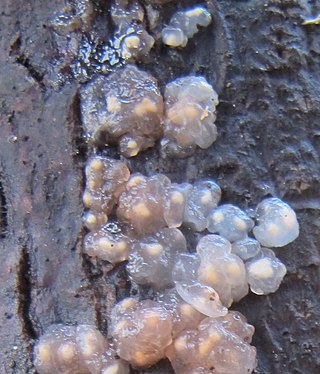
Myxarium is a genus of fungi in the family Hyaloriaceae. Basidiocarps are gelatinous and effused or pustular. The genus is cosmopolitan. All species grow on dead wood or dead herbaceous stems.
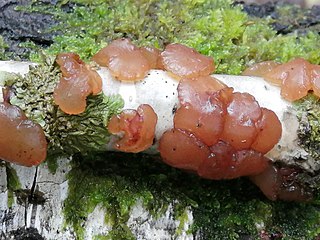
Exidia repanda is a species of fungus in the family Auriculariaceae. In the UK, it has the recommended English name of birch jelly. Basidiocarps are gelatinous, orange-brown, and button-shaped. It typically grows on dead attached twigs and branches of birch and has been recorded from Europe, North America, and Japan.
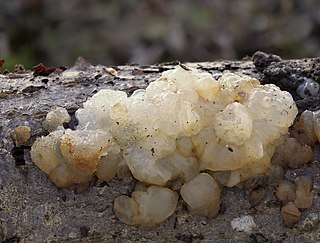
Exidia candida is a species of fungus in the family Auriculariaceae. Basidiocarps are gelatinous, whitish, and cushioned-shaped at first, becoming effused and corrugated.
Exidia purpureocinerea is a species of fungus in the family Auriculariaceae. Basidiocarps are gelatinous, densely covered in small spines, purple-grey, and cushioned-shaped at first, becoming effused. The species occurs in southern Africa on dead wood.
Exidia umbrinella is a species of fungus in the family Auriculariaceae. Basidiocarps are gelatinous, orange-brown, and turbinate (top-shaped). It grows on dead attached twigs and branches of conifers in Europe.
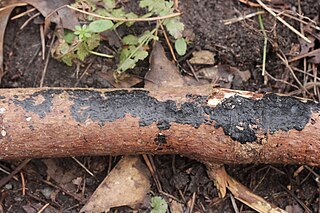
Exidia pithya is a species of fungus in the family Auriculariaceae. Basidiocarps are gelatinous, black, and button-shaped at first, later coalescing and drying to form tar-like patches. The species grows on dead branches of conifers in continental Europe.

















